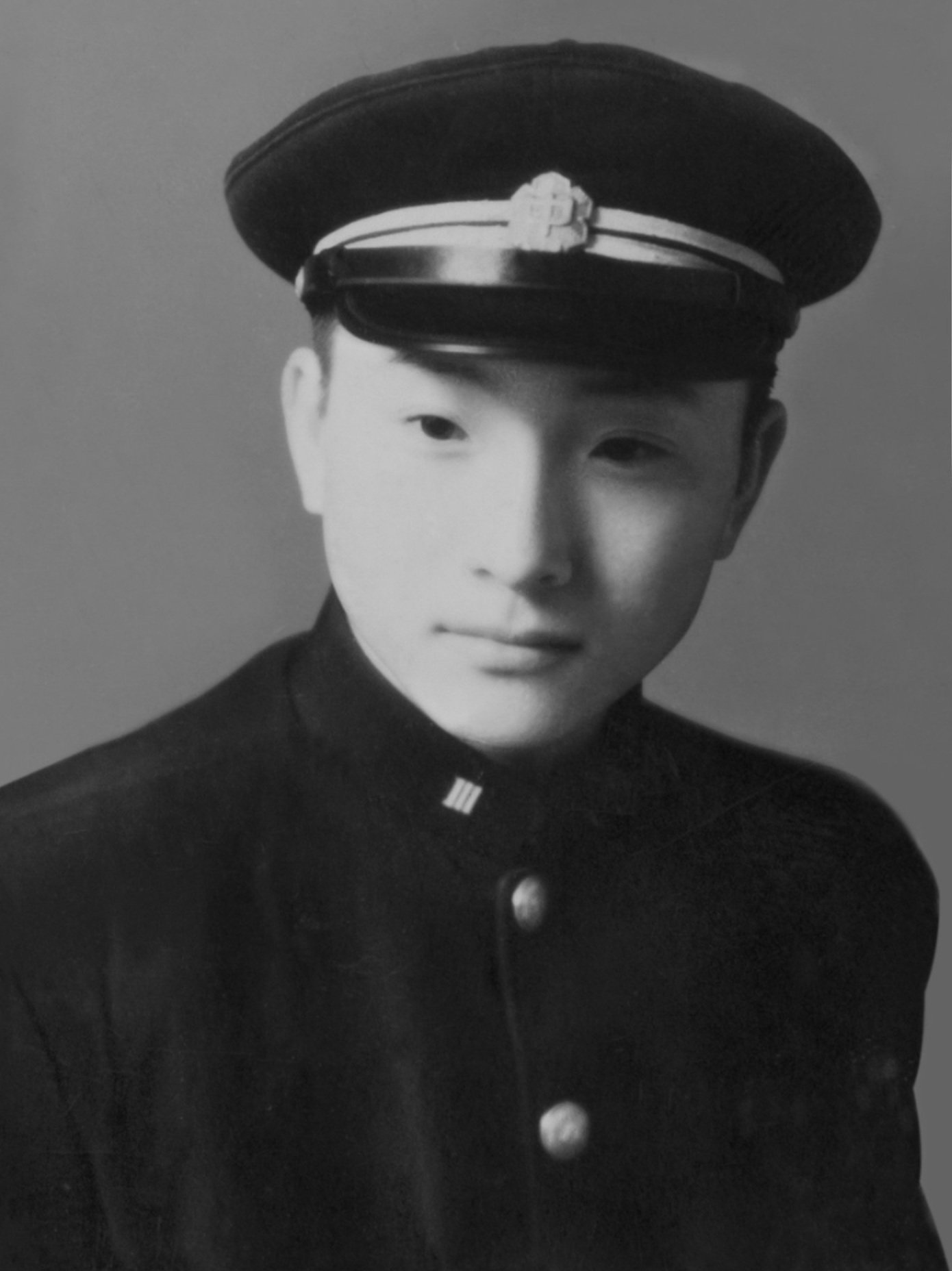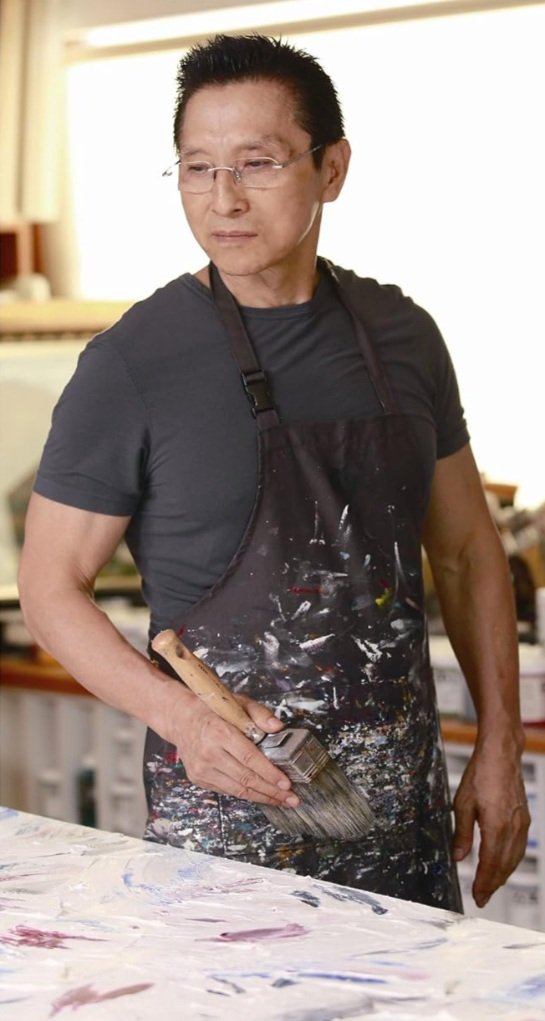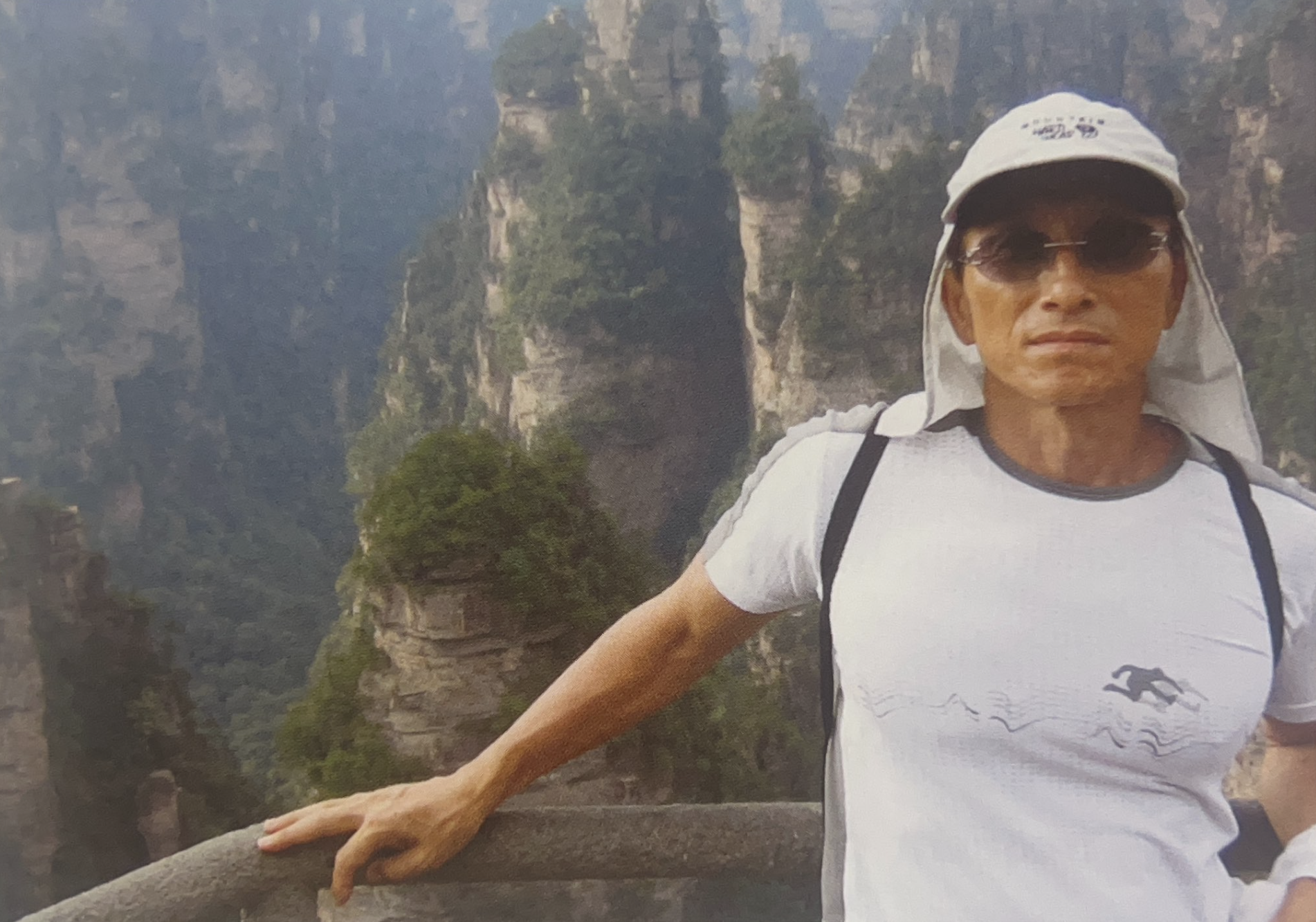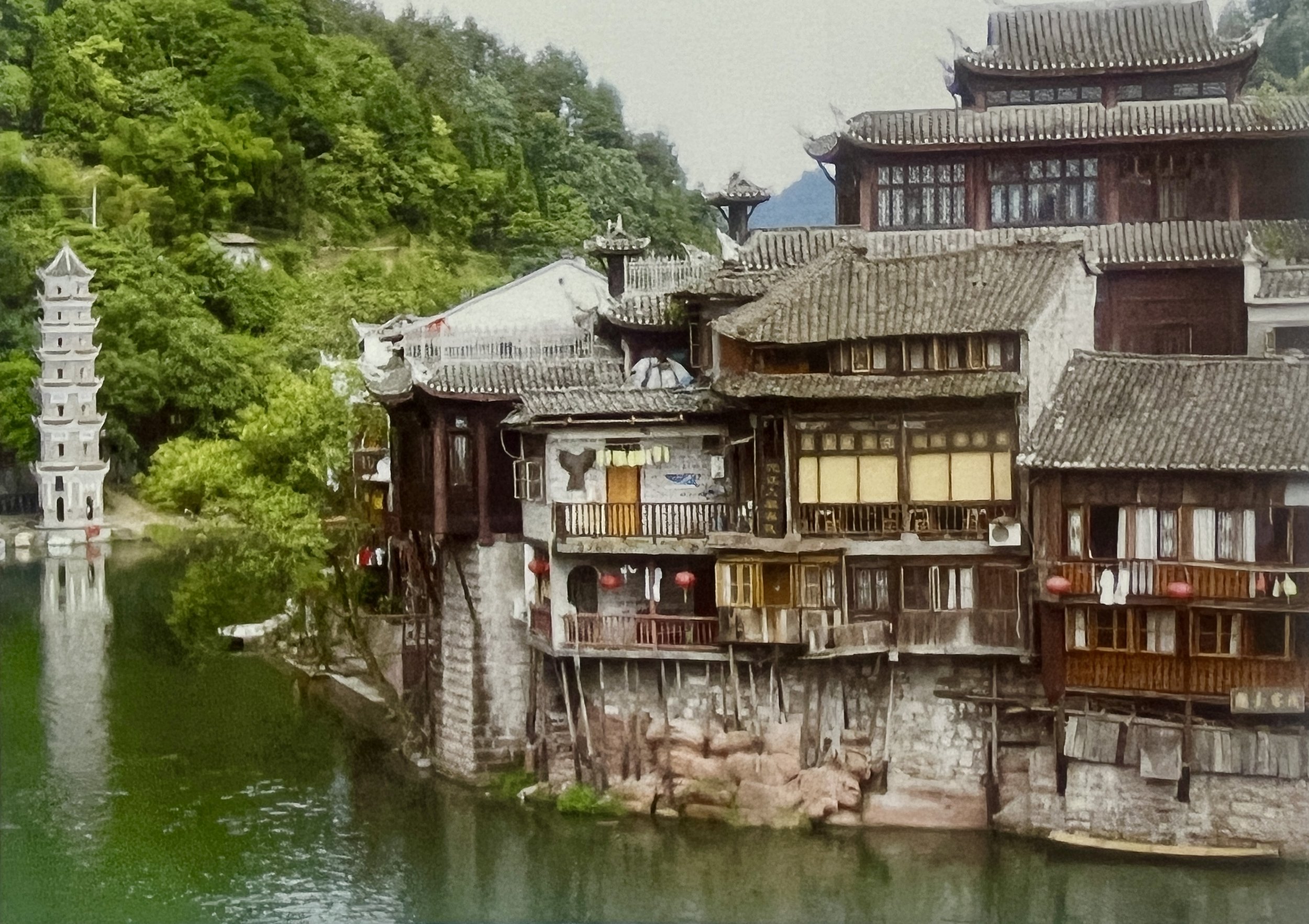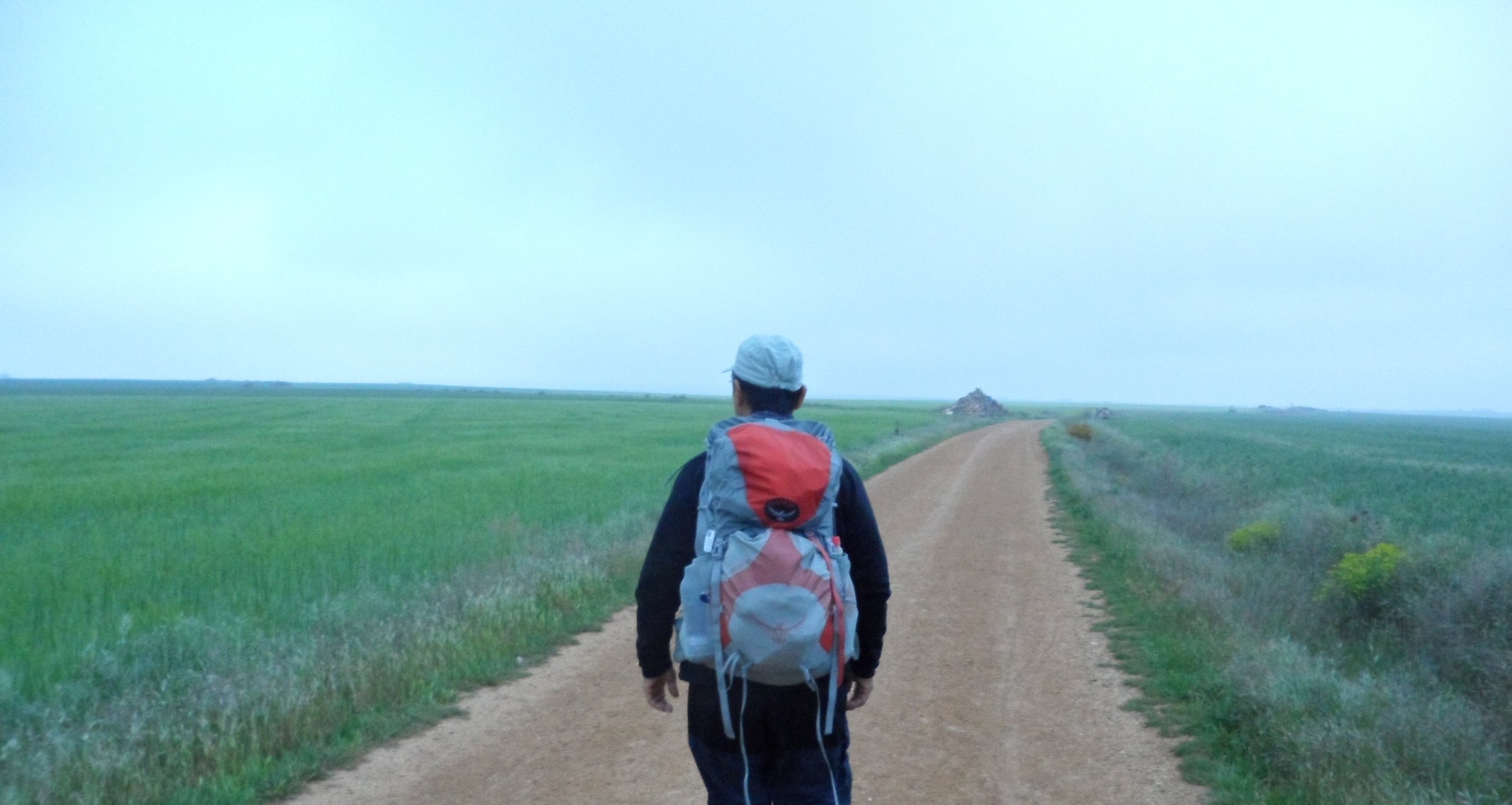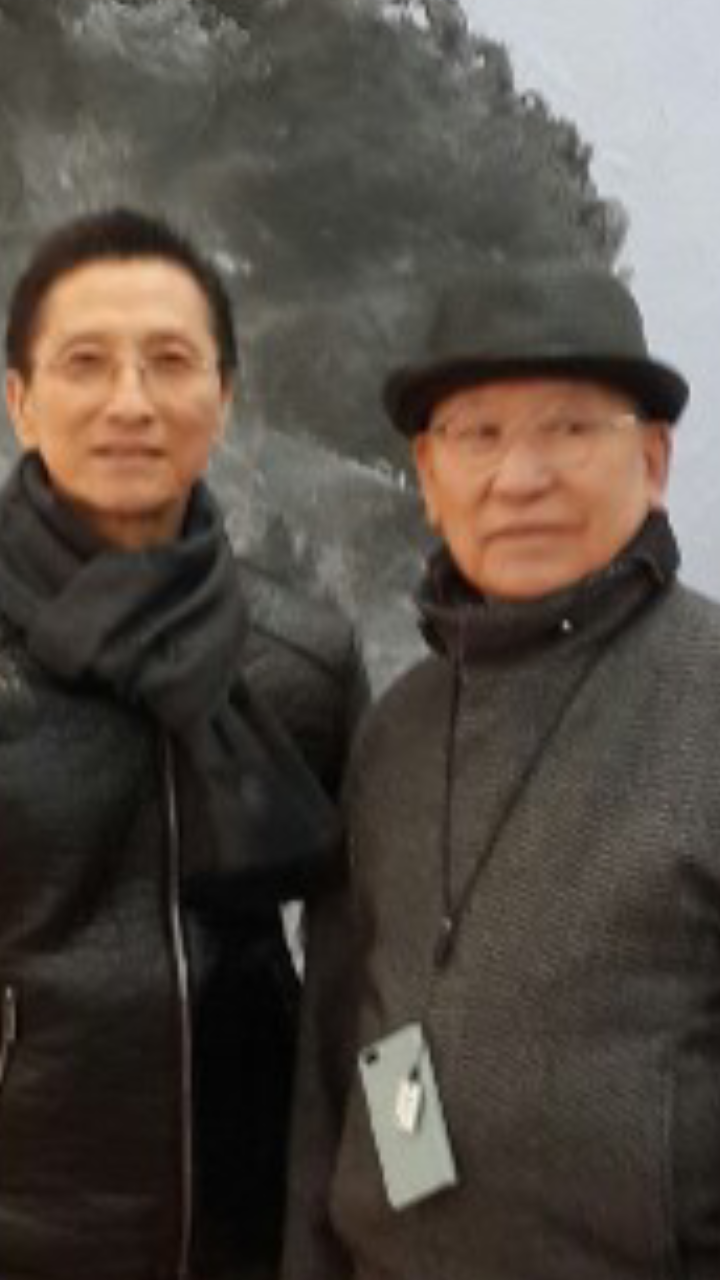Pilgrim From The East
Man Hee in his middle school uniform, 1962
For over sixty years Kim has painted in his native Korea, as well as in Paris and New York where his work became deeply rooted in modernist traditions. Kim began as a painter in the manner of French Realism, Impressionism and Post-Impressionism. Throughout his career he has absorbed a myriad of influences from both the East and the West, yet his work eludes being defined by a single nationality or culture. His points of reference are both more individual and more international in outlook than most abstract painters working today. His evocative transliterations encompass the best of both worlds. Kim has a highly intuitive ability to empty the image of all coherent narrative content, concentrating on pure form with exceptional delicacy and lyrical finesse. By avoiding precise description and freed from literal interpretation, the paintings suggest variable states of mind and mood.
Kim grew up with his family in a small city outside of the Korean capital of Seoul, a densely populated metropolitan area. Distinct from both China and Japan, this ancient and homogeneous civilization dates from 2000 BC. Throughout his formative years, Kim was an inquisitive youth, exploring and scrutinizing his natural and man-made environment with its rich heritage. Kim was keenly interested in art from a very young age and began drawing at about the same time he learned to speak.
In elementary school, his teachers encouraged his compulsion to draw and soon he had advanced to watercolors and plein air work. At the age of ten, he entered a state level art challenge, the Korean National Drawing Competition and succeeded in winning first prize. His award was the Encyclopedia Britannica which he eagerly consumed. The next year he won second prize in the same competition which encouraged him to experiment with other media.
During his junior and senior high school years, Kim was especially a gifted student. He was highly motivated academically, excelling in science and mathematics. However, his unquenchable desire to paint and study art never left him and he pursued extracurricular art classes. When it came time for college, Kim was torn between following his deep love for painting or pursuing the advanced study of science. His parents encouraged his interest in mathematics and science, concerned that he would not be able to make a living as a painter. Kim honored his parents' wishes and finally made the difficult decision to study science instead of art.
Man Hee in his studio in Seoul, South Korea, 2014
In 1968, Kim moved to Japan and enrolled at Hitotsubashi University in Tokyo because the educational system in Korea still lagged behind that of Japan. He received his Bachelor's degree in Social Science in 1972 and his Master's in 1974, followed by a research fellowship in Food Technology in 1975 and 1976. Later on, he was enrolled in a Master's program in the visual arts for a very brief period. Throughout his years in Japan, he traveled extensively and particularly focused on the ancient cultural monuments at Kyoto and Nara. He spoke fluent Japanese and absorbed the visual culture whenever his academic studies permitted. He also continued drawing and painting and widened his exposure to the work of other artists, both past and present. During the summer and winter class breaks, he pursued his first love, painting.
Kim taught Food Technology at Eulji University in Seongnam for twenty-four years. His academic work was intellectually stimulating, yet he came to the realization that his true passion in life was painting. His laboratory experimentation paralleled his experimentation with paint and canvas, testing new techniques and materials.
An unchanging constant during his teaching years was visiting museums and galleries and meeting an ever-expanding circle of artists. Kim's incessant travels to all of the world's continents greatly expanded his artistic vision. Kim was a zealous and devoted traveler, seeking knowledge and new aesthetic experiences, especially at spiritual centers such as Santiago de Compostele. Many of these pilgrimage journeys involved periods of meditation where he was able to deal with his emotions and then transfer them onto canvas.
Man Hee in front of Kinkaku-ji (Temple of the Golden Pavilion) in Kyoto, Japan, 2005
Individual living artists in the West had the most impact on his work, although the New York based Korean painter Po Kim affected him greatly. His major influences were the American Abstract Expressionists, particularly Willem de Kooning for his brilliant color juxtapositions and shapes, brushstrokes and Franz Kline for his sweeping black images. Kim also values Robert Ryman for the highly nuanced surfaces of his white paintings, and the smoothly photo-like finishes of Gerhard Richter's abstract and realist paintings. He became steeped in these artists' work during his frequent trips to Paris where he haunted the Centre Pompidou, as well as numerous other museums and galleries. Kim assimilated contemporary Western painting and learned to grow, transform, and reinvent himself without losing his essential Eastern heritage.
Man Hee at Mount Huangshan, China, 2008
Fenghuang, China taken by Man Hee, 2008
Man Hee hiking at Pobeda Mountain in Kyrgyzstan, 2000
During the past half dozen years the demand for Kim's paintings has resulted in an increase of exhibitions in both the East and the West. Since 2005 his paintings have been shown internationally in invitational solo and group exhibitions: Gallery Couteron and Europe Gallery in Paris; Sunlight Gallery and Salon Hululu Gallery in Tokyo; Repin Academy Museum in St.Petersburg, Russia; Hangaram Art Museum in Seoul; and Able Fine Art Gallery and Walter Wickiser Gallery in New York. He has gained increasing recognition for his painting, especially after focusing on abstraction after 2000. Ironically, Kim has a greater recognition and wider audience in Paris than in his native Seoul.
Kim has mastered a superb fusion of techniques and styles which successfully bridge Western modernist tendencies with the rich heritage of Korean, Chinese and Japanese art. A multi-level cultural interchange between East and West had been transpiring for many years before the triumph of American Abstract Expressionism at mid-twentieth century. In particular, artists throughout Asia began to absorb the new American art, recognizing reflexively that these artists had adopted numerous influences from the East. Kim became keenly aware of these interrelationships, commonalities, and convergences and realized that cross-culturalism is a two-way street.
By exemplifying a meeting and sharing of diverse cultures, Kim assimilated in his work the shifting international cultural landscape. Kim approached the East / West dichotomy by blending Western modernism with the traditional Eastern grammar of rapid gestural brushwork, ink painting, including "sumi" (flung ink), and calligraphic imagery and fragments. In many of his paintings he employed a restriction of color range, including exclusive use of black and white, flat or asymmetrical composition, and the manipulation of positive and negative space. Kim's stylistic tendency openly acknowledge his dual debts to both East and West.
The direct spontaneity of Kim's brushwork may he to the yin and yang of East and West. Indeed, Kim has achieved a delicate balance and harmonization, never allowing his incommensurable signifiers of East or West to become overbearing or domineering. His gift for innovation is grounded in his ability to walk a fine line which activates the interaction of opposites.
Man Hee in Pink City, India, 1999
Man Hee in front of Taj Mahal, India, 1999
Man Hee in Lahore, Pakistan, 1999
For the past seven years, Kim has concentrated his energy and innovative approach on a remarkable series of abstract paintings which represent an exultant culmination of his long career: Journey Santiago de Compostele, Engaged in Animated Conversation, Sensitivity, Wind, and Sound of Spring.
The largest and most imposing of these groupings of his recent paintings is Journey Santiago de Compostele from 2011 to the present. These magnificent paintings were based on his own arduous journey on the Camino de Compostele, literally "the route of the stars" through the Pyrenees to the remote province of Galicia on the northwest coast of Spain. This destination to the cathedral and tomb of St.James the Great, the first Christian martyr and the patron saint of Spain is the third most holy destination in Christendom, after Rome and Jerusalem. Man Hee Kim, the pilgrim from the East, was profoundly effected by this spiritual and visual experience which thousands from all corners of the earth had made since the tenth century AD.
Kim's paintings profoundly bear witness to his spiritual encounters through color, form, and space. Crossing time and space, Kim's work captures the fervor of spiritual travelers down through the ages. As the pilgrim finds a sense of resolution and fulfillment at the end of a strenuous journey, Kim's searching, restless brush finds a balance of image and ground despite the opposing forces of buoyancy and gravity. The spiritual center of these paintings parallels the groundedness felt by the devout believers. For the Christian faithful, specific physical locations such as Santiago de Compostelle or Jerusalem represent an expiation and purification.
Man Hee in his studio in Seoul, South Korea, 2008
The Santiago paintings have a vibrant pictorial richness. In Journey Santiago de Compostelle 6, the thick black lines certainly suggest paths on a journey, as do the tantalizing fragmentary network of lines and elongated shapes. Kim's celebratory emotional drive is decidedly lyrical, with pulsating forces plunging into great depths. In Journey Santiago de Compostelle 7, Kim's subtle integration of black and white with shimmering incandescences of his color harmonies convey a sense of pentimento and rich life beneath the surface. He uses white as both surface and ground to flatten and unify his compositions. Black functions to define and outline shapes, yet in many paintings various colors perform in this capacity. In Journey Santiago de Compostelle 27, his color sequences are arranged in depth rather than simply spread across the surface, with veiled archaeological messages in the underpainting.
Kim's vigorous gestural marks have a rhythmic pulse and energy which emphasize movement and animates his vivid colors. His swirling brushstrokes are frequently so interwoven and encrusted that certain shapes become obliterated entirely. In many of these paintings such as Journey Santiago de Compostelle 29, clusters of marks are emphasized, leaving surrounding areas relatively untouched which create spontaneous color-and-form relationships. Kim frequently creates solid forms from a dense meshing of delicate lines, adroitly balancing masses of dense color. The apparent contradiction of control on the one hand and invention on the other is a line he successfully straddles by simultaneously employing impulsive spontaneity and planned articulation.
Man Hee’s works at RA 31EME ARTEX, Paris, France, 2009
Man Hee with his works in Paris, France, 2005
Man Hee’s exhibition at Salon the Hululu Gallery in Tokyo, Japan, 2008
Man Hee with Po Kim during Man Hee’s solo exhibition at Able Fine Art Gallery, New York, 2011
Man Hee with Park Seo Bo, one of Korea’s most notable painters, at Whanki Museum in Seoul, South Korea, 2011
The other recent series of paintings parallel many of the same ideas and themes of Santiago de Compostelle. The series Engage in Animated Conversation (2008-2014) captures the unbridled, bursting surface energy of its title. The forms, in swift motion, exemplify sharp, staccato sentences and phrases. These paintings suggest associated stories, although they are non-representational and only hint at a potential narrative within the abstract structure of paint and color. Kim sets up a rhythmic counterbalance of forms reminiscent of an interrupted dialogue between two or more people.
In Engage in Animated Conversation 1 and Engage in Animated Conversation 2, the open white areas of the canvas serve as breathing spaces, or conversational pauses between the more saturated hues. The intervals between tight clusters of lines and flat areas relate to patterns of the human voice and the spacing of interrupted dialogue.
The Wind Series (2008-2013) is central to his aesthetic of spiritual exploration and personal discovery. In Wind 5 the wind blowing is transferred to canvas through thick and thin lines, which also represent he paths on a journey. Kim is especially adept at rippling brushwork which denotes wind through a landscape or wind over water. Genesis describes "The spirit moving the wind on the face of the deep" and to God speaking to Job in whirlwind.
In Eastern and Western painting traditionally wind has been accorded a spiritual dimension, associated with the heavens and ethereal light, the animator of creatures of the air, and signifying the elemental forces in nature. The very invisibility of wind makes it the perfect subject for abstract art. Kim apprehends the pure abstraction of the wind, devoid of concrete imagery. In these paintings he reveals the eternal spirit of the wind through its animated effects which are visual and auditory. His free bold brushwork, glowing with resonant, high-pitched color from distant places and other worlds, is emblematic of the unpredictable and sometimes violent character of the wind. For Kim wind represents a circuitous pathway, both permanent and ephemeral. In Wind 1 he especially embraces its fragility and transitory quality in thinly brushed areas of shadow and light with soft edges. Kim's loose and liberated brushwork with unpredictable shifts in direction is set in contrast with tight dense forms with lightly inflected marks, mirroring the winds ever changing moods.
Man Hee’s group exhibition New Abstractions III opening reception at Walter Wickiser Gallery in New York, 2010
Man Hee’s work at Gallery Artist Part IX at Walter Wickiser Gallery in New York, 2012
Man Hee’s work at Art Miami in Miami, Florida, 2010
Man Hee’s work at Art Chicago in Chicago, Illinois, 2011
Man Hee’s work at Houston Fine Art Fair in Houston, Texas, 2013
In each of these series, one can see influences of Helen Frankenthaler, Po Kim, Franz Kline, Willem de Kooning, Morris Louis, Gerhard Richter, Robert Ryman, Lee Ufan, and Park Seo Bo, but it is true Kim synthesizing East and West in his own unique way. in this way Kim's abstractions convey the ambiguity as to their specific source or combination of sources of the forms. The juxtaposition of seemingly unrelated shapes, alternatively curvilinear and rectilinear, may drive from both organic and inorganic sources and generates an understanding of the complex optical fluctuation of the natural world through biomorphism. Kim's amalgamations of hybrid images transform nature through rich and intense color relationships and bravura brushwork. Kim's paintings resonate with a complex mysterious aura of the fusion of East and West. His personal poetic nuances of the brush transcend national identity, positioning his paintings in a globalized perspective of international recognition. Kim's present stature in the twenty-first century art world has indeed been a long journey, as he himself has stated:
"It took me sixty years to learn to follow my heart instead of living only logically. When I painted figural works, I worked with my brain. When I paint abstract works, I work with my heart."
Respecting the physical and formal elements of a lyrically heightened Asian aesthetic, yet learning from European and American modernism, Kim has synthesized the key qualities of both Eastern and Western traditions.
— Robert P. Metzger, PhD
Robert P. Metzger, Director Emeritus of the Reading Museum in Pennsylvania, served in that capacity at the Aldrich Museum, the Allentown Art Museum, and the Stamford Museum. Curator for collectors: W. Hawkins Ferry, Lydia Winston Malbin and Richard Brown Baker. He taught at the University of Detroit and Bucknell University and studied at Columbia, U.C.L.A., Concordia, Wayne University and the Victorian School in London.

